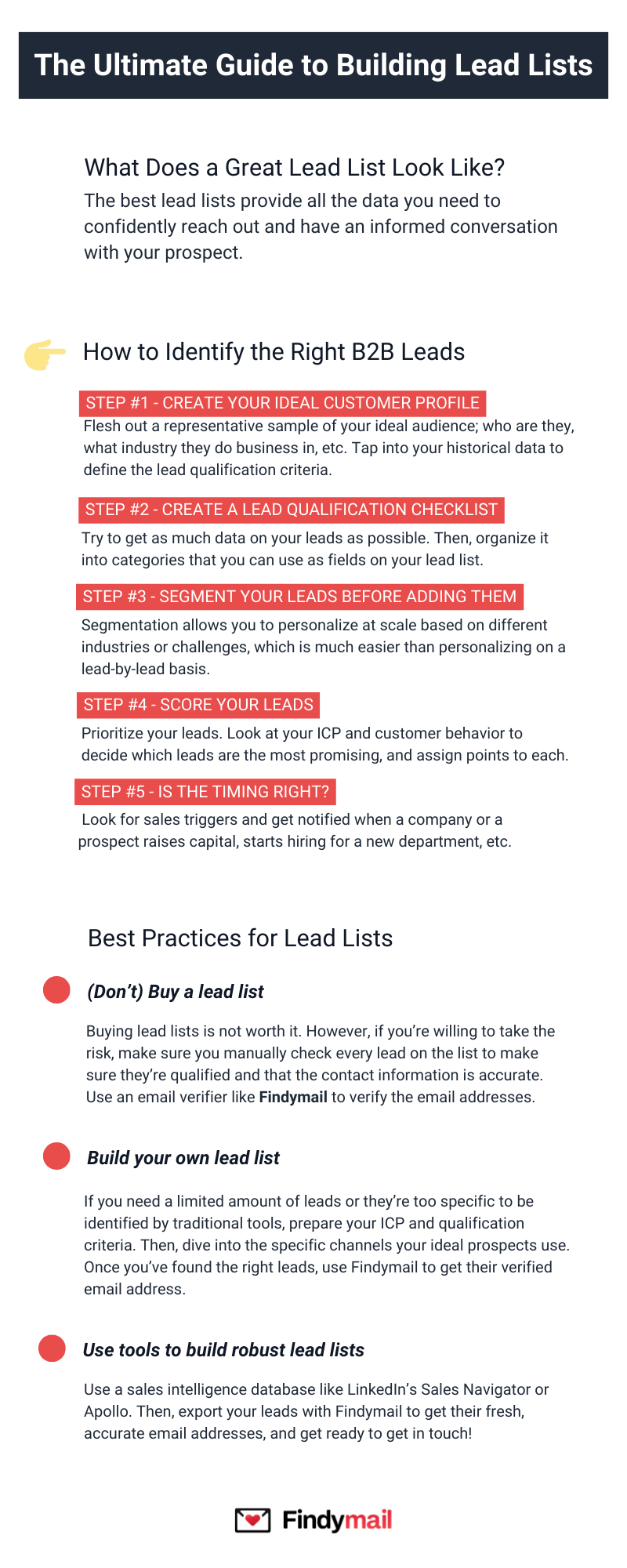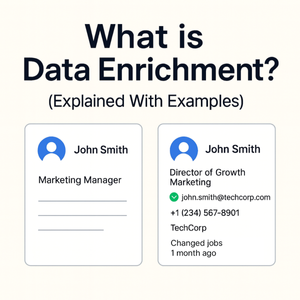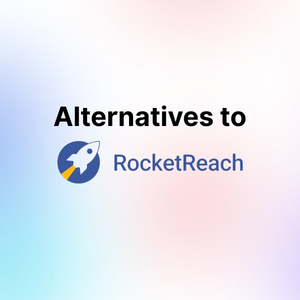Master the art of lead list building with our comprehensive guide covering lead generation strategies, contact information collection, and targeted lead list creation techniques for maximum sales performance.
If you want to grow your business, you need a well-crafted lead list and collection of contact information. But not any old lead list will do! Your prospect quality depends on the source and the data you get on your leads.
So today, I'll walk you through everything you need to know to build a targeted lead list and implement effective lead generation strategies. You'll also get answers to all your questions, including what is a lead list and why lead lists are single-use.
Let's hop to it!

What is a Lead List? Definition and Components
A lead list is a collection of contact information and data about potential customers who have shown interest in your products or services or match your ideal customer profile. Understanding what is a lead list is crucial for successful lead generation strategies.
What Does a Great Lead List Look Like? Key Components and Quality Indicators
The best lead lists give you all the data you need to confidently reach out (be that through cold email or cold call) and have an informed conversation with your prospect.
A quality lead list should include essential components such as verified contact information, demographic data, firmographic details, and behavioral insights that help you create targeted lead lists for better conversion rates.
This looks different for every sales professional.
For example, if your company does a lot of account-based marketing and you don't talk to one buyer but a buying committee, you'll want a company lead list with all the key stakeholders and their contact information.
Conversely, if you're talking to prospects one-on-one, you'll want to zero in on the data describing their specific pain points and solutions they've tried in the past (among other information).
No matter your setup, successful lead list tips include ensuring your lists have these essential elements:
No matter your setup, the best lead lists have a few things in common:
- They provide extensive demographic, firmographic, and psychographic data on your prospects and include comprehensive contact information.
- They have fresh and accurate contact information with verified email addresses and phone numbers.
- They allow you to pre-qualify your prospects so you don't waste time talking to the wrong people and enable targeted lead list strategies.
How Do You Plan to Use Your Lead List?
A good lead generation strategy starts with being clear about why you want it:
- Do you want to create a lead list immediately?
- Do you need to build up a large contact database over time?
- Are there specific types of prospects that excite you and make sense for your business?
Your cold outreach lead list that you compiled yourself won't be identical to the lead list you use in tandem with your marketing team.
For building a lead list successfully, all the leads on your list should be qualified using proven lead generation strategies. This means verifying they have the need, budget, and timing for your solution.
For the highest success rate, all the leads on your list should be qualified, i.e., you should have verified that they have the need and the budget for your solution and that the time is right.
For example, let's say you have 50 prospects on your Sales Navigator lead list. You've set up triggers to get notified when a prospect switches companies because that's your green light. From there, you should export the qualified Sales Navigator leads to your lead list.
The second question you'll want to consider is: where in your sales pipeline will you reach these leads? Have they already been exposed to your company or shown interest? Are they colder than Antarctica in September?
How to Create a Lead List: Identifying the Right B2B Leads
Step 1. Create Your Ideal Customer Profile
Whether a lead is qualified or not is deeply personal to your ideal customer profile (ICP), so team up with your marketing team! Flesh out a representative sample of your ideal audience; who are they, what industry they do business in, etc.
Building a lead list starts with understanding your ideal customer profile, which forms the foundation of effective lead generation strategies and helps you create targeted lead lists.
Tap into your historical data to define the lead qualification criteria. For example, what do the customers who have spent the most, retained the longest, and converted the fastest have in common?
Use the characteristics to flesh out your ICP.
To create your ideal customer profile for lead list building, you'll be looking at factors such as:
To create your ideal customer profile, you'll be looking at factors such as:
- Industries
- Roles
- Employees
- Revenue
- Goals
- Purchase drivers
- Behavioral patterns
Go beyond just firmographics (ARR, employee count) and focus on the criteria individual to your company: which boxes does the lead need to tick in order to qualify, based on your historical performance?
If they don't meet your ICP criteria, they shouldn't be included in your well-crafted lead list tips for optimal results.
If they don't tick the boxes, they shouldn't be on your lead list.
Step 2. Create a Lead Qualification Checklist
Developing a systematic approach to lead qualification is one of the most important tips for lead lists success.
Try to get as much data on your leads as possible (e.g., similar products they've previously used).
Then, organize it into categories that you'll be able to use as fields on your lead list.
At the end of the day, you should have a lead qualification checklist. When adding new leads to your list, you can use it to manually or automatically verify they meet the criteria for your targeted lead list strategies.
Step 3. Segment Your Leads Before Adding Them to the Lead List
Segmentation is crucial when you create a lead list, as it allows for more personalized outreach and better conversion rates through targeted lead list approaches.
Chances are, you don't sell to just one ICP. And when it comes to (cold) outreach, segmentation is key. It'll allow you to personalize more than if you had tried to reach prospects from different industries and with different challenges.
For example, you could have one lead list for manufacturing leads and another for SaaS. Each industry has its challenges, and with a segmented lead list, you'll be able to adapt the value prop to different needs.
Your manufacturing lead could still deal with legacy software, so you'd emphasize how easily your tool replaces it. The SaaS lead may be worried about integration, and you'd mention your API.
You can also segment your leads by source (e.g., inbound vs. outbound marketing), competitors they use, and any criteria that have proven to work for your company when building a lead list.
Step 4. Score your Leads
Lead scoring is an essential component of successful lead list tips that helps prioritize prospects based on their likelihood to convert.
If you want a personalized approach to outreach, you'll need to choose which leads to reach out to first. Look at your ICP and customer behavior to decide which leads are the most promising, and then give them points with lead scoring.
For example, you may realize that leads who tried your competitor 6 months ago tend to churn at that point, so they're most susceptible to a new solution like yours.
Similarly, you could look at the prospect's activities and give them points based on their interactions with your company. The leads with the most points generated from meaningful activities are the ones you should contact first in your targeted lead list strategy.
Step 5. Is the Timing Right?
Timing is critical for effective lead generation strategies and maximizing the value of your lead list collection of contact information.
Finally, look for sales triggers.
You can set them up in most sales intelligence tools to get notified when a company or a prospect raises capital, starts hiring for a new department, and other significant events happen.
If you've been struggling to get through to a lead or set them aside, waiting for the perfect moment, sales triggers will show you when to reach out and activate your well-crafted lead list.
How to Create a Lead List: 3 Proven Methods
Option A: (Don't) Buy a Lead List
While you might be tempted to buy lead lists from providers, this approach rarely delivers the quality needed for successful lead generation strategies.
Let's get this one out of the way. Buying lead lists has been immensely popular in the past decade, but unfortunately, you'll end up with:
- Poorly qualified or unqualified leads. You'll have to spend hours manually reviewing the lists you received and checking the quality of lead lists.
- Outdated information. Most tools and best lead list providers who sell lead lists don't keep them fresh.
- Unverified email addresses. Your emails could end up in a catch-all inbox or not reach the recipient, impairing your deliverability.
Additionally, purchasing lead lists raises concerns about data quality and compliance with privacy regulations when dealing with collection of contact information.
Finally, depending on the country, you could be violating laws like GDPR by contacting the people whose email addresses you found on a scraped lead list.
Instead of relying on purchased lists, focus on building a lead list using proven lead generation strategies that ensure higher quality and compliance.
Buying lead lists is just not worth it!
However, if you're willing to take the risk, make sure you manually check every lead on the list to make sure they're qualified and that the contact information is accurate.
Use an email verifier like Findymail to verify the email addresses or even find them (but we'll get to that in a second) to improve the quality of lead lists you're working with.
Option B: Build Your Own Lead List without Tools
Manual lead list building allows for maximum control over lead quality and ensures you create a lead list that perfectly matches your ideal customer profile.
If you need a limited amount of leads or they're too specific to be identified by traditional cold outreach tools, you can always build a targeted lead list yourself.
Prepare your ICP and qualification criteria. Then, dive into the internet rabbit hole and specific channels your ideal prospects turn to for information using effective lead generation strategies.
Once you've found the right lead, use Findymail to find their verified email address.
Install the Chrome extension, navigate to the lead's website or social media profile (LinkedIn usually works best), and tap on the extension icon. Findymail will track down the right email address and pre-verify it for you ensuring quality lead list components.
Then, add the cleaned-up contact information to your lead list.
Building a lead list step by step takes time, so I only recommend it for the highest-value buyers. For example, you could use this approach for ABM prospects that require you to personalize your communication every step of the way.
A Note on Using Your Inbound Lead List
Inbound lead generation is one of the most cost-effective lead generation strategies, making it essential for building a lead list organically.
Since inbound leads typically cost 61% less than outbound, start generating them if you haven't already!
One way to build a targeted lead list is by generating email signups through your website. You can do this by creating a landing page that offers something of value in exchange for the visitor's contact information.
For example, you could offer an ebook or webinar on resolving a specific pain point.
The key here is that the offer needs to be relevant and valuable enough for people who have never heard of you before—this will help keep email complaints at bay later on down the line when it comes time for those leads to convert into paying customers!
Make sure you qualify your inbound lead list, too. Just because they're interested in your content or a lead magnet doesn't mean they have the need or budget for your services/products.
You can also ask for sales referrals from your existing customers. Chances are, they have peers struggling with similar challenges.
Option C: Use Tools to Help You Build a Robust Lead List
Using advanced tools is one of the most efficient ways to create a lead list while implementing successful lead list tips and lead generation strategies at scale.
For advanced prospecting, consider using an AI-powered lead finder alongside traditional databases like Sales Navigator or Apollo for semantic search capabilities. Both allow you to filter by specific criteria to find leads, including company size, persona match (Apollo), recent funding (Apollo), and more.
Sales Navigator's main perk is the fact that LinkedIn is the professional network for building targeted lead lists.
When prospects have a major update in their company, want to share something they're proud of, or switch workplaces, they'll post about it on LinkedIn. This allows you to set up sales triggers and reach out at the right time.
You can build a lead list within Sales Navigator. Still, suppose you don't want to struggle with LinkedIn's messaging (email addresses are unavailable with Sales Navigator). In that case, you can bulk-export your Sales Nav leads with Findymail to get their verified email addresses.
Export entire lead lists:
Apollo, on the other hand, is a more expensive sales intelligence and engagement platform. You can use it as a contact database and an outreach tool for comprehensive lead generation strategies.
For example, if you're an AE and your sales reps gave you a lead list, you can use Apollo for additional prospect research before you reach out. This can help you pose the right questions to buyers, having understood their business.
Using the persona match feature, you can also find more prospects similar to your ideal customers.
Apollo is going to provide you with contact information for leads. However, if you want to bulk-scrape prospect lists and get the latest email addresses for your prospects, you can use Findymail to verify lead list quality and ensure accurate contact information.
Best Practices for Lead Generation Strategies and List Management
How to Verify Lead List Quality and Maintain Accuracy
Checking lead list quality is essential for successful email marketing and sales outreach campaigns. Regular verification ensures your collection of contact information remains accurate and deliverable.
Key steps to verify lead list quality include using email verification tools, checking for duplicate entries, validating phone numbers, and ensuring compliance with data protection regulations.
Tips for Lead Lists Success and Optimization
Implementing these successful lead list tips will help you maximize your lead generation strategies:
- Regularly update and clean your lead lists to maintain accuracy
- Segment leads based on demographics, behavior, and engagement levels
- Use lead scoring to prioritize high-value prospects
- Implement automated workflows for lead nurturing
- Track and analyze performance metrics to optimize your approach
- Ensure compliance with GDPR, CAN-SPAM, and other regulations
FAQ: Lead List Building and Lead Generation Strategies
What is a lead list and why is it important for sales success?
A lead list is a collection of contact information for potential customers who match your ideal customer profile or have shown interest in your products or services. Lead lists are essential for systematic sales prospecting, targeted marketing campaigns, and revenue generation. A well-crafted lead list helps sales teams focus their efforts on qualified prospects, improving conversion rates and ROI.
How to create a lead list that generates quality prospects?
To create a lead list effectively, start by defining your ideal customer profile, then use lead generation strategies like content marketing, social media prospecting, or sales intelligence tools. Focus on collecting comprehensive contact information including verified emails, phone numbers, and relevant demographic data. Segment your leads based on criteria like industry, company size, and buying behavior to enable targeted outreach campaigns.
What are the best tips for lead lists that convert?
Successful lead list tips include maintaining data accuracy through regular verification, personalizing outreach based on lead segments, implementing lead scoring systems, and timing your outreach strategically. Always comply with data protection regulations, provide value in every interaction, and continuously analyze performance metrics to optimize your approach. Focus on quality over quantity when building your lead lists.
Should I buy lead lists or build them myself?
Building your own lead lists is generally more effective than purchasing them. Self-built lists offer better quality control, higher engagement rates, and compliance with privacy regulations. While you can buy lead lists from providers, purchased lists often contain outdated information, unqualified prospects, and may violate GDPR or CAN-SPAM regulations. Invest time in building targeted lead lists using proven lead generation strategies for better long-term results.
How do I verify lead list quality and ensure accurate contact information?
To verify lead list quality, use email verification tools like Findymail to check email deliverability, validate phone numbers through carrier lookup services, and cross-reference contact information with multiple sources. Regularly clean your lists by removing bounced emails, outdated contacts, and unengaged prospects. Implement automated verification processes and maintain compliance with data protection standards when handling your collection of contact information.






